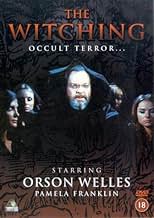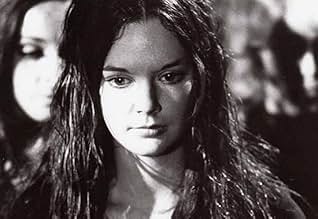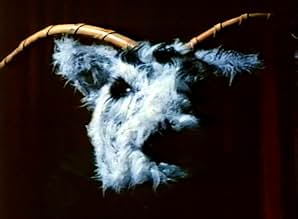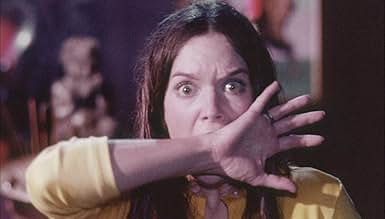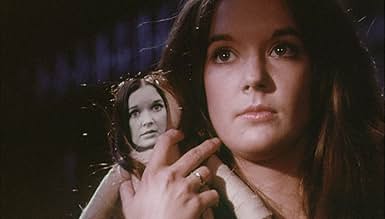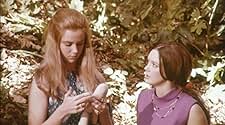CALIFICACIÓN DE IMDb
4.6/10
1.1 k
TU CALIFICACIÓN
Agrega una trama en tu idiomaMr. Cato is the head of a witches' coven in the town of Lilith, where he needs the powers of Lori Brandon to raise his son from the dead.Mr. Cato is the head of a witches' coven in the town of Lilith, where he needs the powers of Lori Brandon to raise his son from the dead.Mr. Cato is the head of a witches' coven in the town of Lilith, where he needs the powers of Lori Brandon to raise his son from the dead.
- Dirección
- Guionistas
- Elenco
Flame Harris Metter
- Black Sabbath Member
- (as 'Flame' Harris Metter)
- Dirección
- Guionistas
- Todo el elenco y el equipo
- Producción, taquilla y más en IMDbPro
Opiniones destacadas
10wouldnti
The film "Necromancy" (1972) was considerably altered for a re-released version which I'm not sure was ever shown in theaters (it may have been a straight-to-video release). This altered version, re-titled "The Witching"(1981, if I'm not mistaken) is apparently only one of several such versions. Since they are under other titles ("A Life For A Life", "Rosemary's Disciples", etc.), I'm assuming (though I'm not certain) that these have been altered further. However, I have seen both "Necromancy" & "The Witching". While the original film (which is next to impossible to find anywhere-though I was able to track down a copy) is a suspenseful, gothic horror film, various key elements were removed for "The Witching", including: the final scene, which clears up some plot points while adding a final twist to the story; both the opening & closing titles, which were replaced with painfully ordinary sequences; & the original music score, which included a memorable song entitled "The Morning After" (not to be confused with the Oscar-winning song of the same title used in "The Poseidon Adventure", released the same year).The new (completely different) music score is horribly, embarassingly cheesy. The sequence of scenes, in some places, was also changed slightly & there was additional (& badly misplaced) footage added. I can only imagine what liberties have been taken with the more recent altered versions, since seeing for myself what else has been done to the original film would be much scarier than "Necromancy" itself.
This drive-in schlockfest has Pamela Franklin starring as a Los Angeles woman who moves to a bizarre small town in Northern California with her husband (Michael Ontkean) where he is to be employed for a toy company. The longer she spends there, the more disconcerted she becomes over the influence his boss, Mr. Cato (Orson Welles), has on the townspeople, which consist exclusively of young, fresh-faced hippies with a taste for all things occult.
"Necromancy" had a troubled release history and was apparently re-edited to some degree in the early 1980s and re-released as a softcore film under the title "The Witching Hour"; the cut of the film I saw was apparently an early R-rated cut under the "Necromancy" title that is allegedly close to writer-director Burt Gordon's original vision, if you want to call it that. "Necromancy" as a whole feels like a "vision" of sorts-a hazy, drugged-out romp through Manson family-era California, with a supernatural twist. It suffers terribly from disjointed editing and a general lack of cohesion, which is disappointing given that the narrative is actually quite straightforward.
The film will remain an eternal curiosity for Welles's involvement, though his role is minimal and his presence generally underwhelming. The lovely Pamela Franklin (who many genre fans know and love from "The Innocents" and "Legend of Hell House") is a formidable lead and does what she can with the material; a strappingly handsome Michael Ontkean plays her husband and is less impressive but still has a likable screen presence; and Lee Purcell (later of Wes Craven's TV schlocker "Summer of Fear") is aptly doe-eyed and dead-faced as a distant member of the town/coven trying to revive Welles's dead son.
The film has a clever albeit rather standard twist that gives it a fun bite considering most of it is rather straightforward despite its acid-trip aesthetics. In the end, the film suffers greatly from serious disjointedness (presumably because it is so badly edited), but there are some ominous, utterly bizarre (and sometimes eerie) visuals throughout that are distinct to the era. Ultimately, what we have here is a drive-in-calibre occult flick, which, depending on who you are, may or may not be a complete delight. For visuals alone, I feel it's worth watching, though it does present itself as a serious case of "what might have been." 7/10.
"Necromancy" had a troubled release history and was apparently re-edited to some degree in the early 1980s and re-released as a softcore film under the title "The Witching Hour"; the cut of the film I saw was apparently an early R-rated cut under the "Necromancy" title that is allegedly close to writer-director Burt Gordon's original vision, if you want to call it that. "Necromancy" as a whole feels like a "vision" of sorts-a hazy, drugged-out romp through Manson family-era California, with a supernatural twist. It suffers terribly from disjointed editing and a general lack of cohesion, which is disappointing given that the narrative is actually quite straightforward.
The film will remain an eternal curiosity for Welles's involvement, though his role is minimal and his presence generally underwhelming. The lovely Pamela Franklin (who many genre fans know and love from "The Innocents" and "Legend of Hell House") is a formidable lead and does what she can with the material; a strappingly handsome Michael Ontkean plays her husband and is less impressive but still has a likable screen presence; and Lee Purcell (later of Wes Craven's TV schlocker "Summer of Fear") is aptly doe-eyed and dead-faced as a distant member of the town/coven trying to revive Welles's dead son.
The film has a clever albeit rather standard twist that gives it a fun bite considering most of it is rather straightforward despite its acid-trip aesthetics. In the end, the film suffers greatly from serious disjointedness (presumably because it is so badly edited), but there are some ominous, utterly bizarre (and sometimes eerie) visuals throughout that are distinct to the era. Ultimately, what we have here is a drive-in-calibre occult flick, which, depending on who you are, may or may not be a complete delight. For visuals alone, I feel it's worth watching, though it does present itself as a serious case of "what might have been." 7/10.
4sol-
A curious low budget horror film, it has two very talented performers at the head of the cast: Pamela Franklin, of 'The Prime of Miss Jean Brodie' and Orson Welles, of many great films. The script does not give either of them the opportunity to maximise their acting potential though, and in fact, the whole story is fairly predictable, quite ordinary or worse. Still, there are a number of atmospheric segments in the film, with fitting music and camera-work setting the mood. It is excessively dark, the odd sound effects are jarring and the cheap special effects do it no good. However, there are some effective moments in the mix. It is not a very good film overall, but it does have some interesting elements. And, for what it is worth, Franklin's acting at times is quite natural.
When you're making a thriller about witchcraft, I believe you should do everything you can to help the audience suspend its disbelief in order for the movie to work. Some pictures ("Rosemary's Baby", for example) have accomplished this; others (like "Necromancy") haven't and the potentially scary material comes across as corny and goofy. This film does have some atmospheric moments, but about half the dialogue is hard to make out (sometimes it's poorly recorded, at other times just incomprehensible) and Orson Welles, who gets top billing, has a role that is so BENEATH him that you have to assume he was desperate for the work. Or maybe he was simply having fun.....(*1/2)
There are two versions of this movie: the original (1971) and a 1983 version ("The Witching"), the latter of which is not worth watching. If you stick to the original, you will find a flawed, but surprisingly effective and dark, horror movie.
While some of the writing and editing is a bit heavy-handed and, frankly, clumsy at points, Pamela Franklin manages to carry this movie admirably. Frankly, the director could have cast just about anyone in the other parts, and I'm not certain it would have mattered. She is at all points the focal point of this film. As such, Welles is just an audience draw. He was by no means essential.
In terms of subject matter, I would put it in the class of movies that came out immediately after "Rosemary's Baby." It is not that movie's equal by any standard. (Stylistically, it is perhaps closer to Romero's "Season of the Witch.") There are many of the same themes: child-birth used for "unnatural" or potentially evil ends; secretive societies within "normal" settings; an alternately naive, sweet/doe-eyed female who is also intelligent, strong-willed and quite perceptive; the often "absent" and not entirely trustworthy husband.
In the end, while this film is not nearly as focused and sharp as RB, the choppy, low-budget feel to the camera work and editing in Necromancy actually works to keep it somewhat phantasmagoric and nightmarish. The ending sequences, with the twist, are actually quite good.
As an aside, the film does appear to have been filmed in part in Los Gatos, California. The funeral scenes appear to have been shot near the Lexington Reservoir, and the exterior shots are likely of houses near the downtown that still stand unchanged, as Los Gatos has retained its "preserve the past" zoning standards --a not unimportant point given the theme of the movie.
While some of the writing and editing is a bit heavy-handed and, frankly, clumsy at points, Pamela Franklin manages to carry this movie admirably. Frankly, the director could have cast just about anyone in the other parts, and I'm not certain it would have mattered. She is at all points the focal point of this film. As such, Welles is just an audience draw. He was by no means essential.
In terms of subject matter, I would put it in the class of movies that came out immediately after "Rosemary's Baby." It is not that movie's equal by any standard. (Stylistically, it is perhaps closer to Romero's "Season of the Witch.") There are many of the same themes: child-birth used for "unnatural" or potentially evil ends; secretive societies within "normal" settings; an alternately naive, sweet/doe-eyed female who is also intelligent, strong-willed and quite perceptive; the often "absent" and not entirely trustworthy husband.
In the end, while this film is not nearly as focused and sharp as RB, the choppy, low-budget feel to the camera work and editing in Necromancy actually works to keep it somewhat phantasmagoric and nightmarish. The ending sequences, with the twist, are actually quite good.
As an aside, the film does appear to have been filmed in part in Los Gatos, California. The funeral scenes appear to have been shot near the Lexington Reservoir, and the exterior shots are likely of houses near the downtown that still stand unchanged, as Los Gatos has retained its "preserve the past" zoning standards --a not unimportant point given the theme of the movie.
¿Sabías que…?
- TriviaActress Pamela Franklin and actor Harvey Jason (The Mad Hungarian from Carrera de locos (1976)) met while making this picture - and have remained married to this very day. Franklin has said in interviews that her marriage is the only good thing to come out of this film.
- ErroresAt 14.52 when the cop gets out of the car he is wearing a motorcycle helmet.
- Versiones alternativasReissue in 1983 under title The Witching had added scenes of full frontal nudity during a coven, including Brinke Stevens.
- ConexionesFeatured in Movie Macabre: Necromancy (1982)
Selecciones populares
Inicia sesión para calificar y agrega a la lista de videos para obtener recomendaciones personalizadas
- How long is Necromancy?Con tecnología de Alexa
Detalles
Contribuir a esta página
Sugiere una edición o agrega el contenido que falta

Principales brechas de datos
By what name was Vida por vida (1972) officially released in India in English?
Responda

